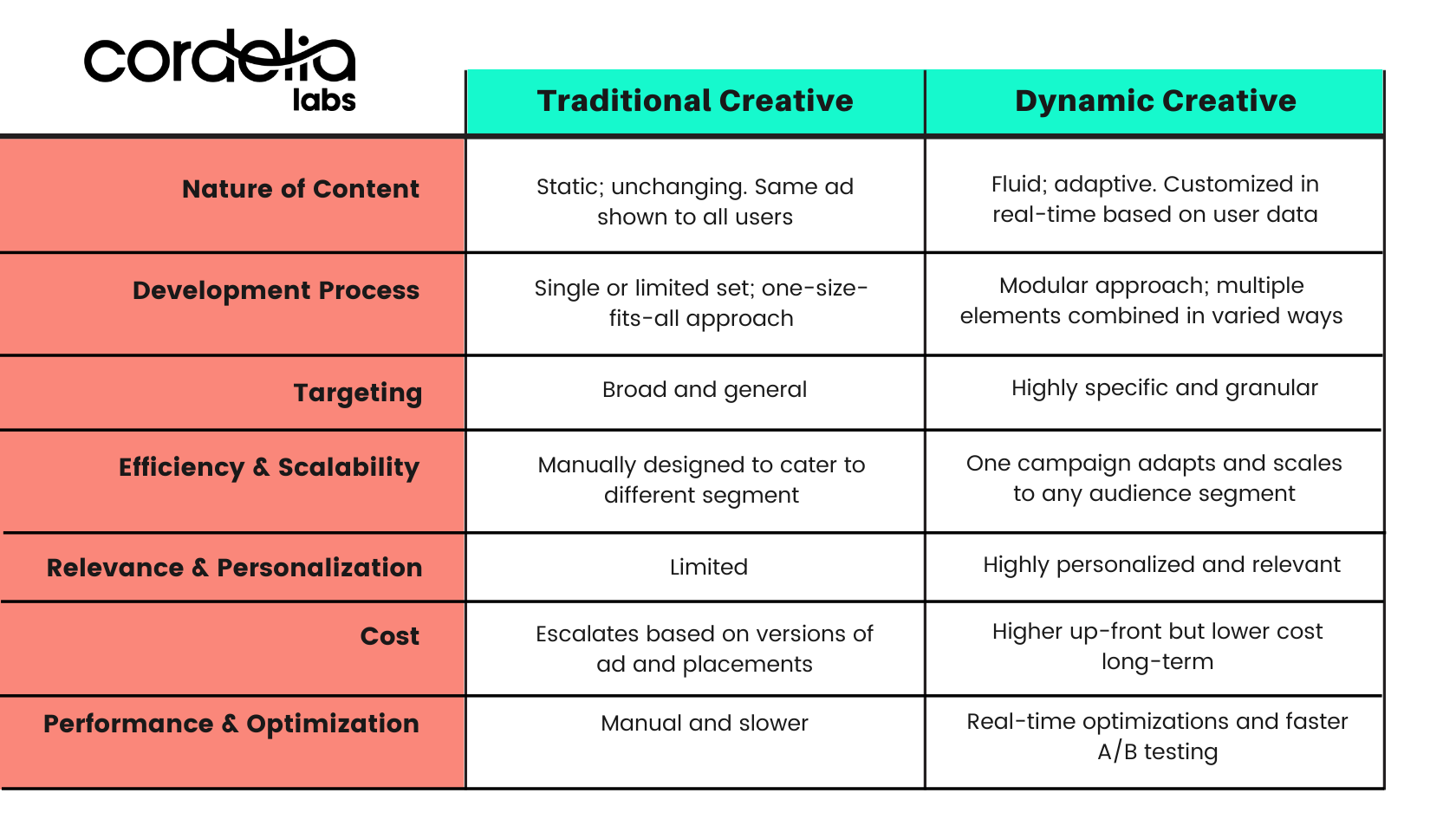What’s the best way to invest in Dynamic Creative?
Dynamic creative is the modern answer to the ever-changing landscape of digital advertising. It’s the process of crafting digital ads that automatically adapt and personalize based on real-time user data. Rather than a one-size-fits-all approach, dynamic creative ensures each user sees the content most pertinent to them.
Why is this approach crucial today? The digital space is crowded. Consumers face a barrage of content daily, making it challenging for brands to get noticed. Dynamic creative cuts through this clutter by delivering tailored messages, leading to better engagement and conversion rates. In the digital age, where adaptability and relevance reign supreme, dynamic creative is not just beneficial—it’s essential.

What is Dynamic Creative?
Dynamic creative is a digital advertising methodology that allows for the real-time customization of ad content based on individual user data. Instead of displaying a single, static ad to a vast audience, dynamic creative technology uses data insights (like user behavior, location, device type, time of day, and other contextual factors) to automatically generate a personalized ad that’s most relevant to the viewer at that moment.
Dynamic Creative is like an A/B test on steroids except the factors that change are multifaceted.
For example, a person browsing online in a cold climate might see an ad for winter coats, while someone in a warmer region might see an advertisement for summer dresses from the same clothing brand.
Dynamic creative offers a smarter, more responsive approach to digital advertising, ensuring that marketing messages are not just seen, but are also relevant and impactful.
What is the difference between traditional digital ad creative and dynamic ad creative?
The biggest difference between a traditional digital ad creative and a dynamic creative campaign is that your creative elements of the creative ad need to be able to be mixed and matched within a bank of assets. A traditional digital ad will be displayed exactly how it is produced. We know this sounds a bit confusing, because it is complicated.
For example, if you break a creative ad down into 4 parts;
- Headline: The headline is the title or main text that grabs the attention of the audience and conveys the main message or value proposition of the ad.
- Body Copy: The body copy is the main text of the ad that provides additional information, details, or persuasive arguments to convince the audience to take action.
- Images or Videos: Visual elements such as images or videos are used to enhance the message of the ad, create visual interest, and engage the audience.
- Call-to-Action (CTA): The call-to-action is a clear and actionable statement that tells the audience what action they should take, such as “Buy Now,” “Sign Up,” or “Learn More.” It is usually accompanied by a button or link that directs the audience to a specific landing page or action.
In a dynamic creative campaign, each of these parts can be customized and personalized based on the audience’s characteristics and preferences, allowing for more targeted and relevant advertising.
The trick is any of the elements that are produced for dynamic creative need to be able to work together. In the example above, you can see that the Headline 1 was mixed with Body Copy 2, Image 2 and CTA 1. But imagine if there were 20 Headers that you can mix with 20 different Body Copies and 20 different images and CTA’s.

How does dynamic creative decide what creative elements to show?
In dynamic creative, decisioning refers to the process of determining which creative elements to display to each individual audience member. This decision is made based on a combination of factors, including the audience’s demographics, interests, browsing behavior, and any other relevant data points.
The decisioning process typically involves the use of algorithms and machine learning techniques. These algorithms analyze the available creative assets and the audience data to determine the most relevant and engaging combination of elements for each individual.
For example, if an audience member is a young female who has shown an interest in fitness, the decisioning algorithm may choose a headline that emphasizes the benefits of a workout, a body copy that highlights the features of a fitness product, an image of a woman exercising, and a call-to-action that encourages the audience member to sign up for a fitness class.
The goal of decisioning in dynamic creative is to deliver personalized and compelling advertisements that are more likely to resonate with each individual audience member, leading to higher engagement and conversion rates.
What are the benefits of dynamic creative?
Dynamic creative offers several benefits that enhance advertising efficiency, relevance, and performance.
- Personalization: Dynamic Creative allows advertisers to tailor their messages to individual audiences based on factors like demographics, interests, and browsing behavior. This personalization increases the relevance of the ads and can lead to higher engagement and conversion rates.
- Increased Engagement: By delivering more customized and compelling advertisements, Dynamic Creative can capture the attention of the audience and encourage them to interact with the ad. This can result in increased click-through rates, time spent on the ad, and overall engagement.
- Optimization: Dynamic Creative utilizes data and algorithms to continuously learn and optimize the content delivered to different audiences. This means that the ads can adapt and improve over time, leading to better performance and results.
- Cost Efficiency: With Dynamic Creative, advertisers can create multiple variations of their ads using the same set of creative assets. This allows for efficient testing and optimization, as well as the ability to reach different segments of the audience without creating entirely new ads.
- Flexibility and Adaptability: Dynamic Creative allows for flexibility in terms of the creative elements used in the ads. Advertisers can mix and match different headlines, body copy, images, and CTAs to create personalized and relevant ads for different audiences. This adaptability ensures that the ads remain fresh and engaging.
- Better Targeting: By leveraging data and algorithms, Dynamic Creative enables advertisers to target specific audiences with precision. This targeting can be based on various factors such as demographics, interests, and previous browsing behavior, ensuring that the ads are shown to the most relevant audience.
- Enhanced Customer Experience: The personalized and relevant nature of Dynamic Creative can lead to a better customer experience. When ads are tailored to their specific needs and interests, customers are more likely to have a positive perception of the brand and be more receptive to the message.
- Improved ROI: Due to the increased engagement, better targeting, and optimization capabilities, Dynamic Creative can ultimately lead to a higher return on investment for advertisers. By delivering more effective and relevant ads, advertisers can achieve their campaign goals more efficiently.
What are the challenges with dynamic creative?
Dynamic creative offers powerful advertising capabilities but comes with its own set of challenges.
One of the primary hurdles is managing data complexity, from ensuring its quality and integration to navigating the growing global emphasis on data privacy. Technical challenges abound too, from setting up dynamic platforms to crafting diverse and consistent ad content. Additionally, while personalization is a strength, there’s a risk of overdoing it, potentially making ads feel invasive to users.
Balancing automation with human judgment, staying compliant with privacy regulations, and mastering the technology and data intricacies are crucial for advertisers looking to harness the full potential of dynamic creative.
How do I know if I should use dynamic creative?
Determining if dynamic creative is right for you hinges on a few key considerations:
- Advertising Goals: Is personalization and improved engagement a priority?
- Audience Diversity: Are you targeting varied segments with different preferences?
- Data Access: Do you have rich, compliant user data to fuel personalization?
- Budget: While dynamic creative may have higher initial costs, the potential for better engagement and ROI can justify the investment.
- Content & Expertise: Can you produce diverse ad elements? Does your team have the technical know-how or the means to acquire it?
- Campaign Scale: For extended or large-scale campaigns, dynamic creative is especially beneficial.
- Feedback & Optimization: If you value real-time feedback and continuous improvement, dynamic creative offers robust tools.
How we can help?
If you’re aiming for tailored advertising with varied audiences and have the resources and data, dynamic creative can be a huge asset. Together with our content and marketing friends at Big Sea, we can create custom dynamic creative assets and scale them to match your goals. Reach out and let’s get started!
